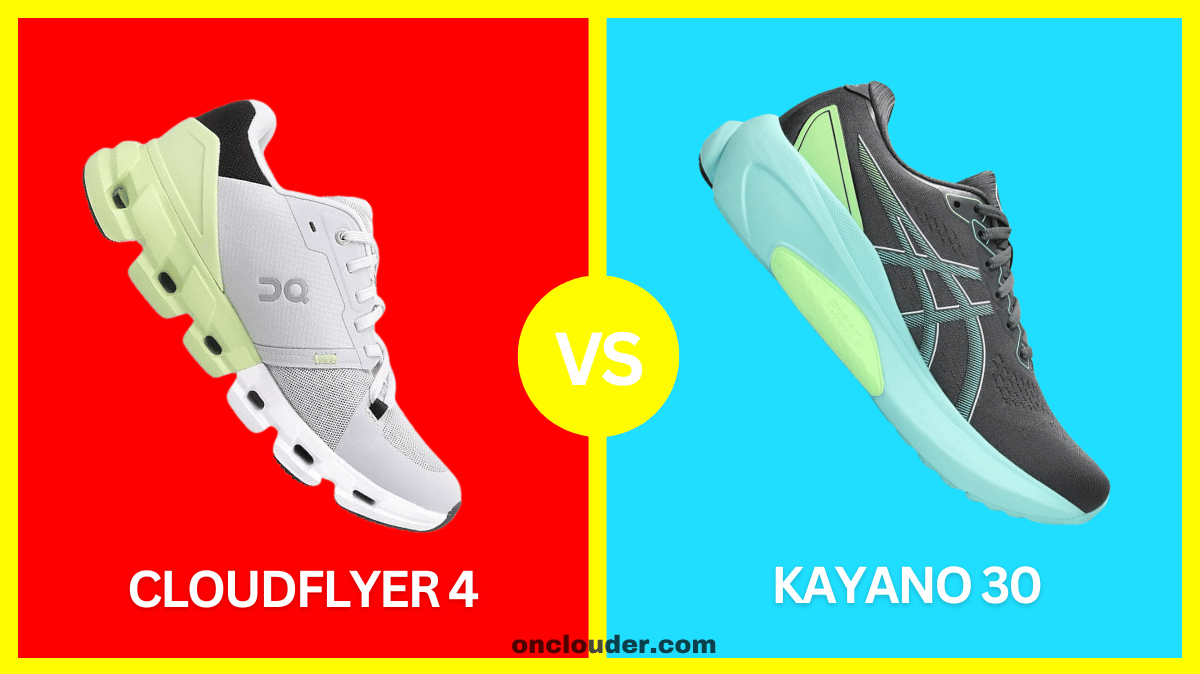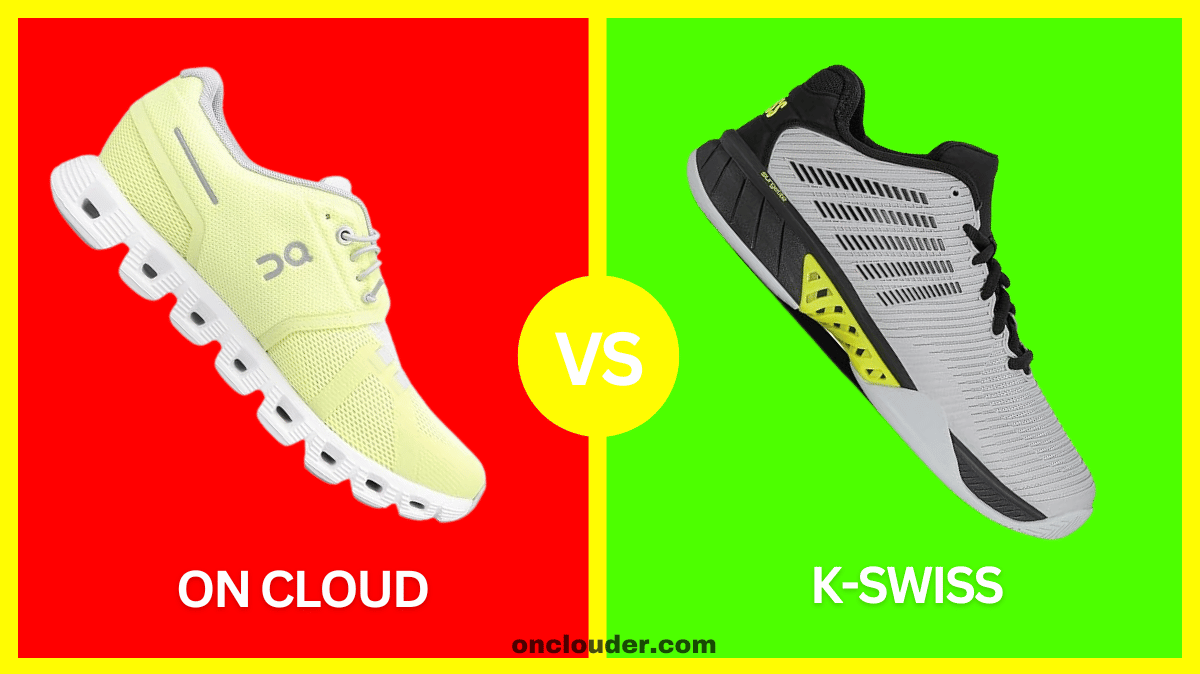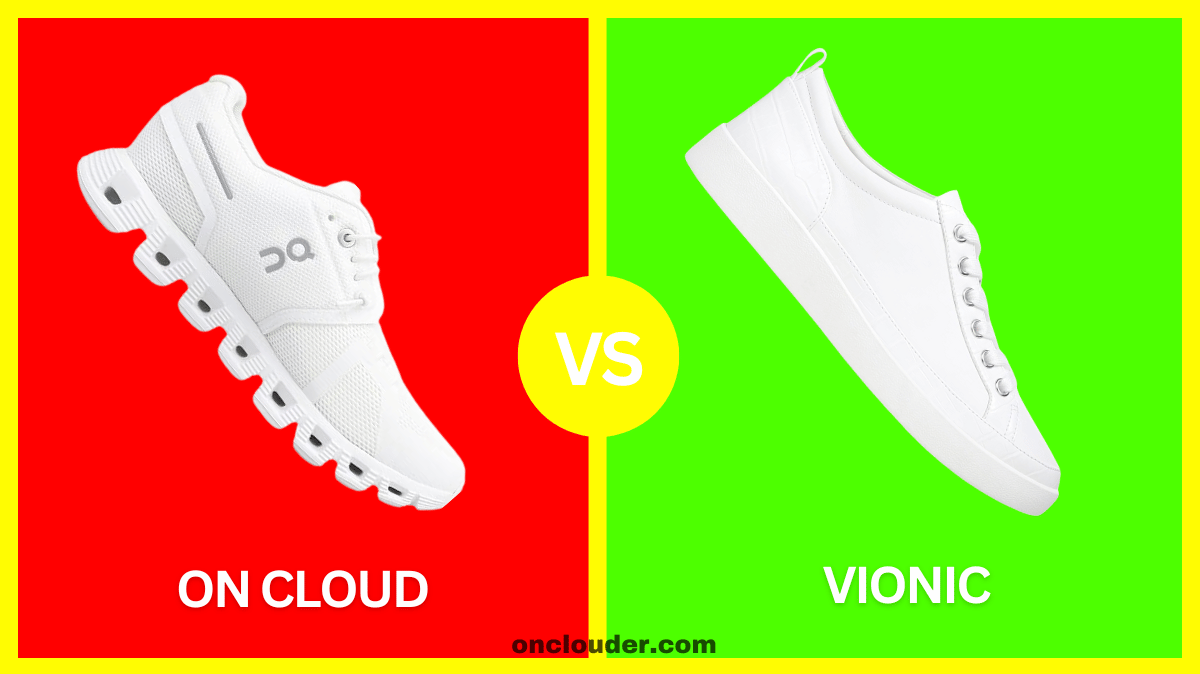Are you ready to lace up and hit the road? Today, we’re going to explore two awesome running shoes that might just become your new best friends: the Cloudflyer 4 and the Kayano 30.
Whether you’re sprinting around the track or jogging in the park, having the right shoes can make all the difference. So, let’s dive in and see how these two popular choices stack up!

Contents
- 1 Quick Comparison: Cloudflyer 4 vs Kayano 30 Shoes
- 2 What Makes a Great Running Shoe?
- 3 Introducing the Contenders
- 4 Durability: Built to Last
- 5 Breathability: Keeping Your Feet Cool
- 6 Cushioning: The Comfort Factor
- 7 Shoe Fit: Finding Your Perfect Match
- 8 Stability: Keeping You Steady
- 9 Comfort: The Feel-Good Factor
- 10 Quality: Built to Impress
- 11 Style: Looking Good While You Run
- 12 Size: Finding the Perfect Fit
- 13 Material: What Are These Shoes Made Of?
- 14 Weight: Light as a Feather?
- 15 Flexibility: Bend It Like a Running Shoe
- 16 Water Resistance: Keeping Your Feet Dry
- 17 Sole: The Foundation of Your Run
- 18 User Reviews: What Do Other Runners Think?
- 19 Price Comparison
- 20 Pros and Cons
- 21 Conclusion
- 22 Frequently Asked Questions
Quick Comparison: Cloudflyer 4 vs Kayano 30 Shoes
The main difference between the Cloudflyer 4 and Kayano 30 shoes is their cushioning technology. The Cloudflyer 4 uses special “cloud” pods that feel bouncy and light, while the Kayano 30 uses gel cushioning for a softer, more supportive feel. Both shoes are great for running, but the Cloudflyer 4 might feel more energetic, and the Kayano 30 might feel more stable.
Now, let’s create a detailed comparison table for Cloudflyer 4 vs Kayano 30 Shoes:
| Feature | Cloudflyer 4 | Kayano 30 |
| Cushioning | “Cloud” pods, bouncy feel | Gel cushioning, soft feel |
| Weight | Lighter (about 280g for men) | Heavier (about 310g for men) |
| Stability | Good, wider base | Excellent, designed for support |
| Breathability | Very good, special mesh | Good, engineered mesh |
| Durability | Good, tough materials | Very good, proven design |
| Best for | Neutral runners, speed | Overpronators, long distances |
| Toe box | Roomy | Standard fit |
| Style | Modern, unique look | Classic running shoe look |
| Price | Around $160-$180 | Around $160-$180 |
| Sizes | Adult sizes only | Adult and kids sizes |
In summary: The Cloudflyer 4 and Kayano 30 are both awesome running shoes, but they’re a bit different. The Cloudflyer 4 feels bouncy and light, which might make you feel faster. It’s great if you like a shoe that feels energetic.
The Kayano 30 feels more stable and supportive, which is good if your feet need extra help staying in line when you run. It’s also great for long runs. Both shoes are comfy and will help you run well, so pick the one that feels best on your feet!
Also Read: Cloudflyer 4 vs Hoka
What Makes a Great Running Shoe?
Before we jump into comparing our two contenders, let’s talk about what makes a running shoe great. When you’re pounding the pavement or cruising on the treadmill, your feet need all the help they can get. Here are some key things to look for:
- Comfort: Your feet should feel like they’re floating on clouds!
- Support: Good shoes keep your feet stable and happy.
- Durability: You want shoes that can keep up with all your adventures.
- Breathability: Nobody likes sweaty, stinky feet, right?
Now that we know what to look for, let’s meet our challengers!
Introducing the Contenders
The Cloudflyer 4: Swiss Engineering at Its Finest
Imagine a shoe that feels like you’re running on fluffy clouds. That’s what the folks at On Running had in mind when they created the Cloudflyer 4. This Swiss-engineered marvel is all about giving you a comfy ride while keeping your feet safe and sound.
The Kayano 30: ASICS’ Legendary Stability Shoe
On the other corner, we have the Kayano 30 from ASICS. This shoe has been around for a while, and it just keeps getting better. It’s like the superhero of running shoes, always there to support you when you need it most.
Durability: Built to Last
When you’re picking out new running shoes, you want them to stick around for a while, right? Let’s see how our contenders measure up in the toughness department.
Cloudflyer 4: The Tough Swiss Cookie
The Cloudflyer 4 is like that friend who’s always up for an adventure. Its outer layer is made of super strong materials that can handle all sorts of weather and terrain. The sole is designed with special “clouds” that not only make your run comfy but also protect the shoe from wear and tear.
Kayano 30: The Marathon Veteran
ASICS has been in the game for a long time, and they know how to make a shoe that lasts. The Kayano 30 uses high-quality rubber on the bottom that grips the ground and doesn’t wear down easily. The upper part is made of sturdy stuff too, so it won’t fall apart even if you wear it every day.
The Verdict: Both shoes are built to last, but the Kayano 30 might have a slight edge due to ASICS’ long history of making durable running shoes.

Breathability: Keeping Your Feet Cool
Nobody likes sweaty, smelly feet. That’s why it’s super important for running shoes to let your feet breathe. Let’s see how our two contenders handle the heat!
Cloudflyer 4: Swiss Air Conditioning
The Cloudflyer 4 is like having a personal fan for your feet. It uses a special mesh material on top that lets air flow in and out easily. This means your feet stay cool and dry, even when you’re running on a hot day.
Kayano 30: The Breezy Runner
ASICS didn’t slack off in this department either. The Kayano 30 has a breathable upper part made of a material called engineered mesh. It’s like tiny windows for your feet, letting the hot air out and the cool air in.
The Verdict: Both shoes do a great job at keeping your feet cool, but the Cloudflyer 4’s innovative mesh might give it a slight advantage in the breathability race.
Cushioning: The Comfort Factor
When you’re running, you want to feel like you’re bouncing on marshmallows, not stomping on rocks. Let’s check out how comfy these shoes are!
Cloudflyer 4: Walking on Clouds
True to its name, the Cloudflyer 4 feels like you’re running on clouds. It uses special foam pods (they actually call them “clouds”!) that squish down when you land and spring back when you push off. This gives you a soft landing and a bouncy take-off.
Kayano 30: The Cushy Classic
The Kayano 30 is no slouch in the comfort department. It uses ASICS’ special gel cushioning in the heel and forefoot. This gel absorbs the shock when your foot hits the ground, kind of like a built-in pillow for your feet.
The Verdict: While both shoes offer excellent cushioning, the unique “cloud” technology of the Cloudflyer 4 might give it a slight edge in providing a more responsive and bouncy feel.
Shoe Fit: Finding Your Perfect Match
Having a shoe that fits just right is super important. It’s like Goldilocks – not too tight, not too loose, but just right!
Cloudflyer 4: Swiss Precision Fit
The Cloudflyer 4 is designed to hug your foot in all the right places. It has a roomy toe box, which means your toes have space to wiggle and spread out naturally. The midfoot area is snug but not too tight, keeping your foot secure without squeezing it.
Kayano 30: Tailored Comfort
ASICS has always been good at making shoes that fit well, and the Kayano 30 is no exception. It has a secure heel fit to prevent slipping, and the upper part of the shoe molds to your foot shape over time.
The Verdict: Both shoes offer excellent fit, but the Cloudflyer 4’s roomier toe box might be preferred by runners with wider feet or those who like more toe space.
Stability: Keeping You Steady
When you’re running, you want shoes that keep you steady and help prevent injuries. Let’s see how our contenders stack up in the stability department.
Cloudflyer 4: Swiss Balance
The Cloudflyer 4 is designed to keep you stable without feeling stiff. It has a wider base that helps prevent your foot from rolling inward (that’s called overpronation). The “clouds” on the sole are arranged in a way that guides your foot to land and push off correctly.
Kayano 30: The Stability King
ASICS has always been known for making stable shoes, and the Kayano 30 is one of their stars. It has special technology in the sole that helps control how your foot moves, preventing it from rolling too much. It’s like having a friendly robot guiding your steps!
The Verdict: While both shoes offer good stability, the Kayano 30 has a slight edge here, especially for runners who need more support or have flat feet.
Also Read: Cloudflyer 4 vs Cloudrunner 2
Comfort: The Feel-Good Factor
Running should feel good, right? Let’s see which shoe might make you feel like you’re floating on air!
Cloudflyer 4: Cloud Nine Comfort
The Cloudflyer 4 is all about making your feet happy. The “cloud” pods on the sole not only provide cushioning but also adapt to your foot shape and running style. The upper part is soft and flexible, wrapping around your foot like a cozy blanket.
Kayano 30: Plush Paradise
The Kayano 30 doesn’t skimp on comfort either. Its gel cushioning system feels soft and squishy under your feet, and the upper part is made of stretchy materials that move with your foot. It’s like wearing a pair of comfy socks with super powers!
The Verdict: Both shoes are designed for maximum comfort, but the unique feel of the Cloudflyer 4’s “cloud” technology might give it a slight edge for some runners.

Quality: Built to Impress
When you’re spending your hard-earned allowance on running shoes, you want to make sure you’re getting top-notch quality. Let’s see how our contenders measure up!
Cloudflyer 4: Swiss Precision
On Running, the company behind the Cloudflyer 4, is known for its attention to detail. Every part of the shoe is carefully designed and made with high-quality materials. From the special foam used in the “clouds” to the durable outer layer, this shoe screams quality.
Kayano 30: Time-Tested Excellence
ASICS has been making the Kayano line for 30 versions now, and they’ve had plenty of time to perfect it. The materials used are top-notch, and the shoe is put together with care. It’s like they’ve been practicing making this shoe for years… because they have!
The Verdict: Both shoes offer excellent quality. The Cloudflyer 4 brings innovative materials and design, while the Kayano 30 benefits from years of refinement.
Style: Looking Good While You Run
Let’s face it, looking cool while you run is important too! Here’s how our contenders stack up in the style department.
Cloudflyer 4: Swiss Chic
The Cloudflyer 4 has a sleek, modern look that stands out from the crowd. Its unique sole design with the “cloud” pods gives it a futuristic vibe. It comes in a range of cool colors, from classic white to eye-catching combinations.
Kayano 30: Classic Cool
The Kayano 30 has a more traditional running shoe look, but that doesn’t mean it’s boring! It has sleek lines and comes in a variety of color options to suit different tastes. Whether you prefer bold and bright or subtle and sophisticated, there’s a Kayano 30 for you.
The Verdict: Style is subjective, but the Cloudflyer 4 might have an edge for those who like a more unique, modern look.
Size: Finding the Perfect Fit
Getting the right size is super important for comfort and preventing injuries. Let’s see how our contenders handle sizing.
Cloudflyer 4: True to Size
The Cloudflyer 4 generally runs true to size, which means you can usually order your regular shoe size. However, its roomy toe box might make it feel a bit bigger than some other running shoes.
Kayano 30: Consistent Sizing
ASICS is known for consistent sizing across their shoes. The Kayano 30 typically fits true to size, but some runners find they need to go up a half size for the perfect fit, especially if they have wider feet.
The Verdict: Both shoes offer consistent sizing, but it’s always best to try them on if possible or check the brand’s sizing guide before ordering.
Material: What Are These Shoes Made Of?
The materials used in running shoes can make a big difference in how they feel and perform. Let’s take a closer look at what goes into our contenders.
Cloudflyer 4: High-Tech Fabrics
The Cloudflyer 4 uses a mix of high-tech materials. The upper is made of a breathable mesh that’s both light and durable. The sole uses On’s special Helion™ superfoam, which is designed to be light, bouncy, and long-lasting.
Kayano 30: Tried and True
The Kayano 30 uses a combination of trusted materials. The upper is made of engineered mesh for breathability and support. The midsole uses ASICS’ FlyteFoam technology for cushioning, and there’s gel in key areas for extra shock absorption.
The Verdict: Both shoes use high-quality materials, but the Cloudflyer 4’s innovative Helion™ foam might give it an edge in terms of unique feel and performance.
Weight: Light as a Feather?
When you’re running, every ounce counts. Lighter shoes can help you feel faster and less tired. Let’s see how our contenders weigh in!
Cloudflyer 4: Swiss Lightness
The Cloudflyer 4 is designed to be light despite its cushioning and support features. A typical pair weighs around 280 grams (9.8 oz) for men and 230 grams (8.1 oz) for women.
Kayano 30: Balancing Act
The Kayano 30 is slightly heavier due to its extensive support features. A typical pair weighs about 310 grams (10.9 oz) for men and 260 grams (9.2 oz) for women.
The Verdict: The Cloudflyer 4 is the lighter shoe, which might be preferred by runners looking for a more nimble feel.
Also Read: Cloudflyer 4 vs Cloudflyer 3
Flexibility: Bend It Like a Running Shoe
A good running shoe should move with your foot, not against it. Let’s see how flexible our contenders are!
Cloudflyer 4: Swiss Flexibility
The Cloudflyer 4 is designed to be flexible in the right places. The “cloud” pods on the sole allow for natural foot movement, and the upper material bends easily with your foot.
Kayano 30: Structured Flexibility
The Kayano 30 offers a good balance of flexibility and support. It’s more flexible in the forefoot area to allow for natural toe-off, but stiffer in the midfoot for stability.
The Verdict: The Cloudflyer 4 might offer more overall flexibility, while the Kayano 30 provides a more structured flex.

Water Resistance: Keeping Your Feet Dry
Sometimes you have to run in the rain or through puddles. Let’s see how our shoes handle wet conditions!
Cloudflyer 4: Swiss Weather Protection
While not fully waterproof, the Cloudflyer 4 has good water-resistant properties. The upper mesh is treated to repel water, helping to keep your feet dry in light rain or when running through dewy grass.
Kayano 30: Ready for Drizzles
The Kayano 30 also offers some water resistance. Its engineered mesh upper helps to keep water out, though it’s not designed for very wet conditions.
The Verdict: Both shoes offer similar levels of water resistance, suitable for light rain but not for heavy downpours or deep puddles.
Sole: The Foundation of Your Run
The sole of a running shoe is super important. It’s what connects you to the ground and helps you push off with each step. Let’s check out the soles of our contenders!
Cloudflyer 4: Cloud-Powered Propulsion
The Cloudflyer 4’s sole is where the magic happens. It features On’s signature CloudTec® technology – those funky-looking “cloud” elements that compress when you land and spring back when you take off. The sole also has a Speedboard™, a stiff plate that helps propel you forward.
Kayano 30: Gel-Cushioned Comfort
The Kayano 30’s sole is all about cushioning and support. It uses ASICS’ famous gel technology in the heel and forefoot for shock absorption. The sole also features the TRUSSTIC™ system under the arch, which helps prevent the shoe from twisting.
The Verdict: Both soles offer great technology, but they have different feels. The Cloudflyer 4 might feel more responsive and bouncy, while the Kayano 30 might feel more cushioned and stable.
User Reviews: What Do Other Runners Think?
Let’s see what other people who’ve tried these shoes have to say!
| Shoe | Average Rating | Comments |
| Cloudflyer 4 | ⭐⭐⭐⭐½ | “Super comfy!”, “Feels bouncy”, “Great for long runs” |
| Kayano 30 | ⭐⭐⭐⭐ | “Very supportive”, “Helped my knee pain”, “Durable” |
Price Comparison
Here’s a quick look at how much these shoes might cost:
| Shoe | Price Range |
| Cloudflyer 4 | $160 – $180 |
| Kayano 30 | $160 – $180 |
Remember, prices can change and might be different depending on where you buy them!
Pros and Cons
| Shoe | Pros ✅ | Cons ⚠️ |
| Cloudflyer 4 | Very light and bouncy | Might feel too soft for some runners |
| Unique, cool-looking design | Only comes in adult sizes | |
| Roomy toe box for comfy toes | Might not be the best for flat feet | |
| Good for fast runs and races | Can be slippery on wet surfaces | |
| Very breathable, keeps feet cool | Some runners find the fit unusual | |
| Kayano 30 | Great support for flat feet | Heavier than some other running shoes |
| Very stable, helps with wobbly ankles | Might feel too firm for some runners | |
| Durable, lasts a long time | Less bouncy feel | |
| Good for long runs and everyday use | Classic look might be boring for some | |
| Comes in kids sizes too | Can get warm on hot days |
Conclusion
After all this comparing, you might be wondering which shoe comes out on top. The truth is, both the Cloudflyer 4 and the Kayano 30 are awesome shoes! The best one for you depends on what you need:
- If you want a lighter, bouncier feel with a unique design, go for the Cloudflyer 4.
- If you need more support and stability, especially if you have flat feet, the Kayano 30 might be your bestbet.
- Remember, the perfect running shoe is the one that feels right on your feet. If you can, try both shoes on and see which one makes you feel like you could run forever!
Frequently Asked Questions
Can I use these shoes for other sports besides running?
Great question! While both the Cloudflyer 4 and Kayano 30 are designed primarily for running, they can be used for other activities too. They’re great for walking, gym workouts, and even casual wear.
However, if you’re doing a lot of side-to-side movements like in tennis or basketball, you might want to look for shoes specifically designed for those sports.
How often should I replace my running shoes?
Another awesome question! Generally, you should think about replacing your running shoes every 400-500 miles (that’s about 640-800 kilometers). For most people, this means getting new shoes every 4-6 months. But if you notice that the soles are wearing down or the shoes don’t feel as comfy anymore, it might be time to replace them sooner.
Are these shoes good for people with flat feet?
Yes, both shoes can work for people with flat feet, but the Kayano 30 might be a better choice. It offers more support and stability, which can help if you have flat feet or if your feet tend to roll inward when you run (that’s called overpronation). The Cloudflyer 4 also provides good support, but it’s not as specialized for flat feet as the Kayano 30.
Can I wear these shoes if I have wide feet?
Good thinking! Both shoes come in different widths, so you should be able to find a size that fits you comfortably. The Cloudflyer 4 has a roomier toe box, which might be more comfortable for wide feet. The Kayano 30 also offers wide sizes. Remember, it’s always best to try shoes on or check the sizing guide before buying!
Are these shoes waterproof?
Great question! Neither the Cloudflyer 4 nor the Kayano 30 is fully waterproof. They both have water-resistant properties, which means they can handle light rain or running through dewy grass. But if you’re planning on running in heavy rain or through puddles, your feet might get wet. If you need fully waterproof shoes, you might want to look for shoes specifically designed for wet conditions.




